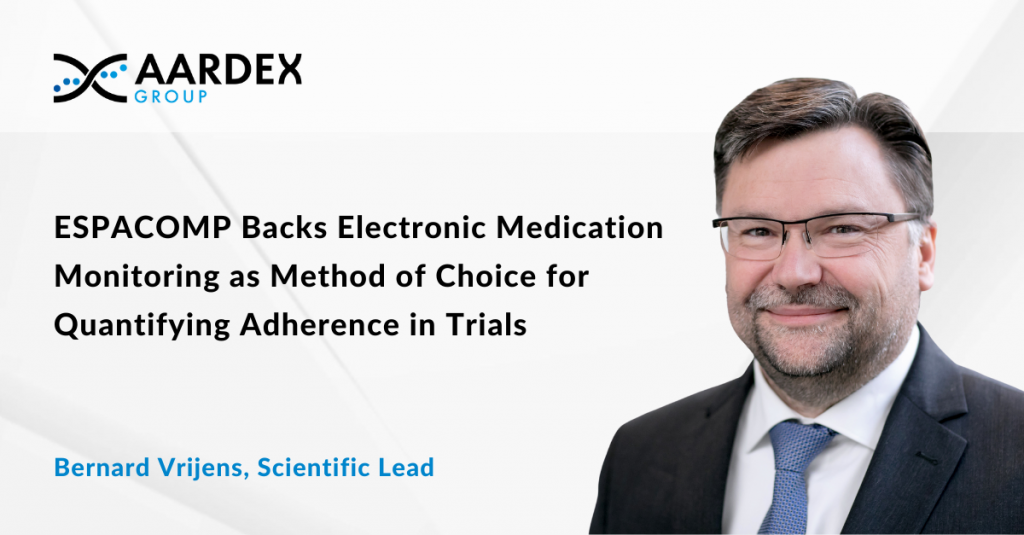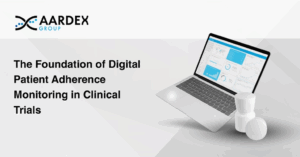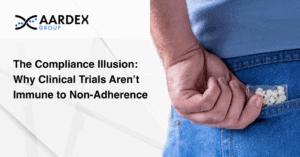Effectively measuring medication adherence relies on selecting the most appropriate data source – and for clinical trials, that data source is electronic medication monitoring.
The TEOS (timelines-events-objectives-source) guideline provides a clear framework on how to assess medicine-taking behavior relative to the scenario, and a new review paper makes clear that electronic medication monitoring is the method of choice for drug development1
What is TEOS?2
The TEOS framework builds on the established “initiation, implementation, and persistence” taxonomy of medication monitoring, providing practical recommendations on how to identify and report medicine-taking behavior.
Developed by the International Society for Medication Adherence (ESPACOMP), it outlines four actions for the “good operationalization” of observing adherence in a study sample:
- T: Describe treatment as four simultaneous, interdependent timelines, namely prescribing, recommended dosing, dispensing, and actual dosing
- E: Break initiation, implementation, and persistence down into four key events along these timelines: first and last recommended use, first and last actual use
- O: Revisit study objectives to fine-tune research questions and assess measurement validity and reliability needs
- S: Select the data sources (e.g., electronic monitoring, self-report, electronic healthcare databases) that best address measurement needs
In a follow-up paper published this year, the ESACOMP adherence methodology working group looked at how best to match measurement needs to data source, analyzing the utility of self-report, electronic monitoring, and electronic health databases.
What is Electronic Medication Monitoring?
Electronic medication monitoring encompasses a range of approaches, but at AARDEX Group it comprises combining the power of digitally enabled medication adherence packaging and real-time analytics.
Electronic sensors in the device, whether that’s a smart pre-filled syringe (PFS), electronic blister pack, or smart pill bottle, automatically record dose administration and transmits the data to AARDEX Group’s Medication Adherence Software, MEMS AS®.
The cloud-based platform then performs a detailed analysis of the medication-taking behaviors, spots erratic dosing patterns, and presents that information as powerful visualizations to guide interventions.
It’s an evidence-based approach that seeks to solve many of the challenges associated with traditional forms of adherence measurement, such as pill count or self-report, which are vulnerable to bias and subjectivity, and the often-invasive biomarker monitoring.
Clinical Trials, TEOS, and Electronic Medication Monitoring1
Thanks to its accuracy and its ability to collect granular data, electronic medication monitoring is perfectly suited to measuring adherence during clinical trials.
The review paper authors mapped each TEOS step to the most appropriate data source.
Timelines
With regards to timelines, they said that information on actual use is central to medication adherence estimation.
“The necessity of collecting data on prescribing, dispensing, and recommended use depends on whether there is variation in these timelines in the study population,” they said.
“In some studies, particularly clinical trials, the same medication is prescribed and dispensed according to the protocol to all study participants; in these cases, variation only occurs in actual use, and additional information is only needed on the (invariable) dosing recommendation.”
Events
The next TEOS step is events, which focuses on defining initiation, implementation, and persistence events and thresholds.
Said the authors: “To estimate these phases precisely, it is necessary to ensure that they are correctly delimited for all study participants and adherence phases are aligned between participants for comparison. Thus, we need to situate in time at least the prescription start and end, and the first and last use event.”
It went on to say that, in clinical trials, these dates are set by the study protocol, and the electronic monitoring could accurately collect the data required for comparison.
“In electronic monitoring, data collection starts from the first medication intake using the device; if the device is adopted at treatment initiation, the first event recorded corresponds to the first actual dose. The last medication intake using the device may occur earlier than the last actual use, whether planned or by non-adherence to device use.”
Unlike self-report, which is open to bias, and electronic health databases, which rely on prescribing information, electronic monitoring devices collect “fine-grained data” on actual medication use.
“It is, therefore, the data source of choice when all patients follow the same regimen for the whole study duration in a controlled setting,” said the paper.
Objectives
The TEOS framework suggests adherence researchers consider using the data source best suited to the study’s objectives. The key is being able to not only monitor but quantify the difference between recommended and actual dosing patterns.
Electronic monitoring, the paper says, allows the most granular record of actual use making it the “method of choice” for studying patterns of deviation from recommended use during implementation.
What’s more, it can collect large amounts of longitudinal data. This enables the analysis of “within-patient and between-patient variation” that could point to potential causes of poor adherence and add to the knowledge base.
“Linked with pharmacokinetic or pharmacodynamic information, electronic monitoring data can support therapeutic drug monitoring, and facilitate greater understanding of the effects of variable implementation on drug response,” said the paper.
Sources
Accurate measurement of adherence must be based on accurate data sources – and studies have shown electronic medication monitoring to be 97% accurate, compared to 60% for pill count, and just 27% for self-report.3
As the review paper highlights, electronic monitoring data are time-stamped device use events, pertaining to the opening of a pharmaceutical package, or the use of a device (PFS, inhaler). But it also warns that reliability can be influenced by device acceptability, adding it was “essential that these devices do not add burden to patients nor induce stigma”.
Gold standard monitoring
Measuring medication adherence during clinical trials is essential. Poor adherence can lead to underestimations of drug efficacy and drain study power to the point of failure. What’s more, an accurate view of medicine-taking behaviors during development can provide additional insights into the drug products’ impact and characteristics.
However, it can also be complex, not least due to the wide variety of data sources to choose from. But in the structured world of clinical trials, where the focus is on a single medication, the protocol defines clear start and end dates, follow-up visits are scheduled, and all patients follow the regimen specified in the study protocol, electronic medication monitoring is the gold standard.
- Dima, A. L., Allemann, S. S., Dunbar‐Jacob, J., Hughes, D. A., Vrijens, B., & Wilson, I. B. (2022). Methodological considerations on estimating medication adherence from self‐report, electronic monitoring, and electronic healthcare databases using the TEOS framework. British Journal of Clinical Pharmacology.
- Dima, Alexandra L., et al. “TEOS: A framework for constructing operational definitions of medication adherence based on Timelines–Events–Objectives–Sources.” British Journal of Clinical Pharmacology 87.6 (2021): 2521-2533.
- El Alili, M., Vrijens, B., Demonceau, J., Evers, S. M., & Hiligsmann, M. (2016). A scoping review of studies comparing the medication event monitoring system (MEMS) with alternative methods for measuring medication adherence. British journal of clinical pharmacology, 82(1), 268-279.



